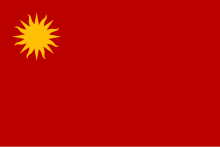Red flag (politics)
In politics, a red flag is predominantly a symbol of left-wing ideologies, including socialism, communism, anarchism, and the labour movement.
In the Middle Ages, ships in combat flew long red streamers called baucans or bauccedillian to signify a fight with no quarter.
A red flag was raised over the Champ-de-Mars in Paris on July 17, 1791, by Gilbert du Motier, marquis de Lafayette, commander of the National Guard, as a symbol of martial law, warning rioters to disperse.
Inverting the original symbolism, the Jacobins protested this action by flying a red flag to honour the "martyrs' blood" of those who had been killed.
[citation needed] Two red flags soaked in calf's blood were flown by marchers in South Wales during the Merthyr Rising of 1831.
The red flags of Merthyr became a potent relic following the execution of early trade unionist Dic Penderyn (Richard Lewis) in August 1831, despite a public campaign to pardon him.
[8][9] During the Battle of the Alamo in March 1836, General Antonio López de Santa Anna of Mexico signified no quarter by displaying a plain blood-red flag (approx.
This prolonged struggle received considerable attention and sympathy from liberals and revolutionaries in Europe; Giuseppe Garibaldi first made a name for himself in 1843, having been inspired to have his troops wear the famous Red Shirts.
The original red banners of the Paris Commune became icons of the socialist revolution; in 1921, members of the French Communist Party came to Moscow and presented the new Soviet government with one of the original Commune banners; it remains in place in the tomb of Vladimir Lenin, next to his open coffin.
[16] In the Haymarket affair, during which a bomb blast killed a police officer at a May Day rally for an eight-hour workday in Chicago, anarchists flew red flags.
[citation needed] Streets, buildings, businesses and product brands named after the red flag are common in China as a result of recuperation.
[citation needed] For example, a famous line of limousine cars manufactured by China FAW Group Corporation has the brand name of Red Flag.
The more floral red rose design has subsequently been adopted by a number of other socialist and social-democratic parties throughout Europe.
Civilian establishments that were awarded with the Order of the Red Banner of Labour were also sometimes addressed with the "Red-Banner" honorific.
[citation needed] The Transferable Red Banner (Russian: переходящее Красное знамя) was an award for Soviet collectives in various workplaces that won socialist emulation contests.
The term "transferable" means that for a given kind of competition at a given establishment (enterprise, school, institute, clinic, etc.)










